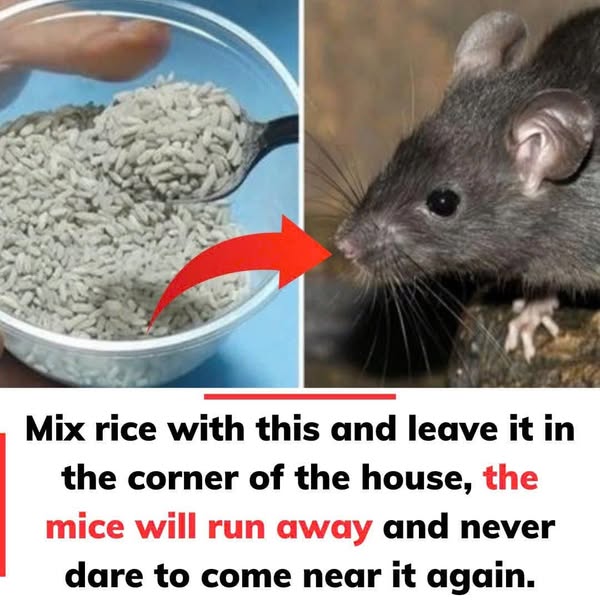Mice may seem small and harmless, but once they find their way into your home, they can create chaos. From gnawed wires to shredded fabrics and contaminated food, these tiny invaders are more than just a nuisance—they’re a real threat to both your comfort and your health. Most people turn to traps, poisons, or professional exterminators, but what if you could get rid of mice using something as simple and natural as rice? Believe it or not, when rice is mixed with one specific ingredient and placed strategically around the house, mice don’t just leave—they stay gone.

This surprisingly simple solution has been quietly passed down through generations, especially in rural areas where natural remedies and home hacks are the first line of defense against household pests. It’s safe, non-toxic, cheap, and easy to set up in minutes. So, what is this mystery ingredient that turns plain rice into a mouse-repelling powerhouse? The answer is baking soda—a common kitchen staple that, when used correctly, can help you reclaim your home from rodents without putting your family or pets at risk.
Let’s explore the science, the method, and the reasons why this DIY technique is gaining attention—and why it might just be the best-kept secret for a pest-free home.
Why Mice Are So Hard to Get Rid Of
Before we dive into the method, it’s important to understand why mice can be such persistent houseguests. Mice are incredibly adaptable, fast breeders, and can squeeze through openings as small as a dime. Once they find food, water, and shelter—your home becomes their perfect sanctuary. They build nests inside walls, behind appliances, and even in storage boxes.
Worse still, they leave behind droppings, urine trails, and pheromones that attract more mice to the area. That’s why it’s not enough to catch or kill a few—you need to prevent more from coming and convince the rest to leave.
The Secret Weapon: Rice + Baking Soda
Here’s how the method works:
Rice acts as a bait. It’s dry, easy to store, and has a neutral smell. Mice are naturally curious and constantly scavenging for food, so they’ll nibble on almost anything left out—especially grains.
Baking soda (sodium bicarbonate) is where the magic happens. It’s completely safe for humans and pets but reacts fatally inside a mouse’s digestive system. When a mouse eats rice laced with baking soda, the baking soda mixes with the stomach acids and produces carbon dioxide gas. Unlike humans, mice cannot burp or expel gas efficiently. The buildup of gas becomes fatal. It sounds a bit graphic, but it’s a much more humane and silent method than glue traps or poison blocks.
Step-by-Step: How to Make and Use It
Ingredients:
-
1 cup of uncooked white rice (avoid flavored or oily rice)
-
2 tablespoons of baking soda
-
A few drops of peanut butter or vanilla extract (optional, for stronger bait)
Instructions:
-
Mix the ingredients: Combine the rice and baking soda in a bowl. Stir well to ensure the baking soda is evenly distributed.
-
Add a scent lure (optional): Mice have an acute sense of smell. If you want to make the mixture even more appealing, add a drop or two of vanilla extract or a dab of peanut butter. Mix thoroughly.
-
Place in shallow containers: Use small bottle caps, lids, or pieces of paper as trays. Spoon a little bit of the mixture into each.
-
Strategic placement: Place the containers in corners, behind furniture, under sinks, in cupboards, and anywhere you’ve seen signs of mice (droppings, gnawed items, or scratching sounds).
-
Monitor and refresh: Check every few days. Replace the mixture weekly or if it becomes damp.
-
Seal entry points: This step is crucial. Once the mice leave or die off, seal any holes or cracks to prevent re-entry. Use steel wool and caulk for small holes or consult a handyman for larger gaps.
Why This Method Works So Well
-
Non-toxic and pet-safe: Unlike commercial rodenticides, which can be harmful to children, dogs, or cats, this solution is completely safe unless consumed in extremely large amounts (which is unlikely with baking soda).
-
No foul odor: Traps or poison often leave you with the problem of finding and disposing of dead mice. In contrast, this method causes the mice to leave the area in search of fresh air or water—or perish discreetly in their nests with far less odor.
-
Cheap and accessible: Rice and baking soda are found in nearly every kitchen. You won’t need to spend money on expensive traps or monthly pest control visits.
-
Silent and stress-free: No snapping traps, no messy glue boards, and no struggling animals. This method works silently and efficiently in the background.
Tips for Better Results
-
Keep your home clean: Mice are attracted to crumbs, open food containers, and garbage. Keep kitchen counters clean, use airtight food containers, and take out the trash regularly.
-
Remove nesting spots: Cluttered garages, basements, and attics make perfect nesting grounds. Clear out boxes, old clothing, and piles of paper or fabric.
-
Use in combination with essential oils: If you want extra protection, place cotton balls soaked in peppermint oil or eucalyptus oil near your bait trays. These scents naturally repel mice and mask any lingering pheromones.
-
Track their movements: Sprinkle a light dusting of flour along the floor near baseboards or suspected mouse paths. Footprints will tell you where to place your bait.
Common Questions Answered
Q: Will this work for rats too?
A: It’s most effective for mice, due to their smaller size and digestive system. For rats, larger quantities and stronger deterrents may be needed.
Q: Is baking soda safe to leave around pets?
A: Yes, in small amounts. Just make sure pets don’t eat large quantities of the bait. Place trays in hidden or hard-to-reach areas if needed.
Q: How long does it take to work?
A: Some users report results within 3–5 days. However, it depends on the number of mice and how frequently they consume the bait.
Q: Can I use cooked rice instead of raw?
A: No. Cooked rice will spoil and attract insects. Raw rice is dry, durable, and more suitable for this long-term use.
Final Thoughts
Mice may be clever and persistent, but nature has its own tricks too. By combining a common grain with a harmless household powder, you can take control of your home without harsh chemicals, expensive exterminators, or sleepless nights listening to scratching sounds in the walls.
This simple method of mixing rice with baking soda and placing it in the corners of your house is more than just an old-school hack—it’s a practical, cost-effective way to manage pests that doesn’t harm your environment or put your family at risk.
Whether you live in a city apartment or a countryside home, this trick is worth trying. Sometimes, the best solutions are the ones right under our noses—or in our kitchen cabinets.
So the next time you hear the pitter-patter of tiny feet at night or find mysterious nibbles in your pantry, don’t panic. Just reach for your rice and baking soda, mix it up, and give nature a little help in keeping your home safe, quiet, and mouse-free.

